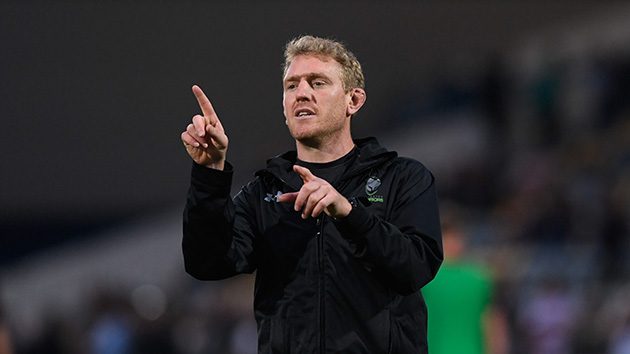Worcester’s backs coach Sam Vesty explains the merits of picking a second playmaker at 12
“The George Ford-Owen Farrell partnership is a bedrock of England’s game,” says Sam Vesty, co-founder of prorugbycoach.com and a Level Four coach at Sixways. “If you get it right, playing two ball-players can give opponents twice as many headaches.” Here Worcester backs coach Vesty explains how…
1. OFF SET-PIECE
“An extra ball-player allows you to move the ball to the outside channels quicker and more effectively, and you can better exploit dummy lines and strike runners. It doubles the width of your play, giving you a threat across the whole width of the pitch.”

On the ball: Wasps fly-half Danny Cipriani with a pop pass against Leicester. Photo: Getty Images
2. EXTRA PAIR OF EYES
“Vision is vital. The 10 controls everything inside him (ruck, short side), 12 controls everything outside him (organising wings and full-back). The 12 can communicate with his 10 better than a non ball-player, and to forwards in the wider channels.”

Chief ambition: Gareth Steenson and Henry Slade during Exeter training. Photo: Getty Images
3. SECOND LINE OF ATTACK
“The second ball-player connects your game up and gives you options at the line. You can put a playmaker behind two separate pods of forwards and have the ability to play either flat through the forwards or pass out the back.”

Pivotal figures: George Ford leading an attack for England. Photo: Getty Images
4. SPLITTING THE FIELD
“With two playmakers you have two sides to attack. Set up either side of a breakdown and their backfield has to cover the 12’s boot as well as the 10. Whether kicking or moving the ball through the hands, you create a nightmare for their back three.”

Vision express: Australia’s Bernard Foley oversees a scrum. Photo: Getty Images
5. MAN UP!
“Some ball-players are weak defenders but at least one of your 10-12 pairing needs to be a robust tackler. For England, Owen Farrell whacks above his weight and that enables your defence to have more width, with no shoulders turning in.”

Teaming up: Jimmy Gopperth and Danny Cipriani tackle Brad Barritt. Photo: Getty Images
6. EFFICIENT EXITS
“Fielding two ball-players allows you to kick to either touchline when you’re under the pump, and it’s hard for the opposition to put the press on two kickers. Having a left-footed kicker, like Danny Cipriani or Henry Slade, also gives you an advantage.”

Kick on: Henry Slade clears the ball downfield. Photo: Getty Images
WHAT YOU COULD DO
- To drill two lines of attack: get forwards running off 10 in hard lines, and a second ball-player out the back running off him. Whatever you practise will turn up on Saturday, so keep repping.
- To upskill your passing, play a touch game where you must move the ball three passes away from contact.

Point made: Worcester coach Sam Vesty gets his message across. Photo: Getty Images
- Don’t worry about shirt numbers – get your best players in the key roles. For example, you might use 15 as a second ball-player, as Sarries do with Alex Goode.
- Play a game (touch or full contact) where only the 12 can talk. It helps him get used to organising players.
- Play a touch game where the defence is only allowed one player in the backfield (rest in the line). The key is to isolate the space behind.
This article first appeared in the February 2017 issue of Rugby World. For the latest subscription offers, click here.






